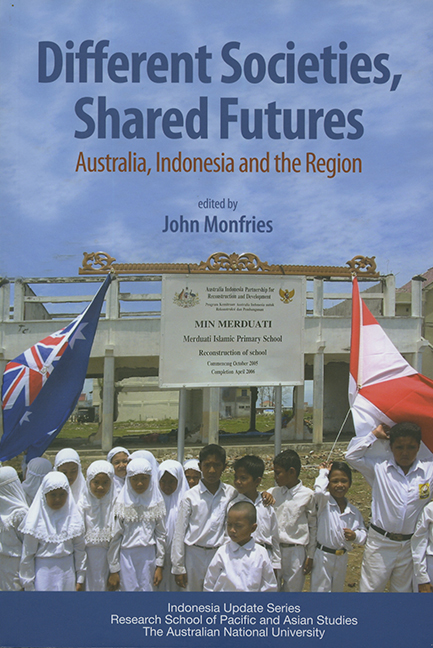Book contents
- Frontmatter
- Dedication
- Contents
- Tables
- Figures
- Contributors
- Acknowledgments
- Opening Address by Richard Woolcott AC
- 1 Introduction
- PART I Regional Viewpoints
- PART II Security Aspects
- PART III Mutual Perceptions and Irritations
- PART IV The Economic Partnership: Aid, Economics and Business
- PART V Conclusion
- Glossary
- References
- Index
1 - Introduction
Published online by Cambridge University Press: 21 October 2015
- Frontmatter
- Dedication
- Contents
- Tables
- Figures
- Contributors
- Acknowledgments
- Opening Address by Richard Woolcott AC
- 1 Introduction
- PART I Regional Viewpoints
- PART II Security Aspects
- PART III Mutual Perceptions and Irritations
- PART IV The Economic Partnership: Aid, Economics and Business
- PART V Conclusion
- Glossary
- References
- Index
Summary
The 2005 Update conference, the 23rd in the series, was the first to address specifically the relationship between Indonesia and Australia, in the context of the region in which both countries are located. Readers may wonder why it took so long for the subject to be covered, but the Update has usually focused on internal developments in Indonesia. Recent conferences have covered, for example, Indonesian history, environmental issues and women's issues.
THEMES AND ISSUES
After the decision on the topic was taken, two momentous events made the topic even more current and worthwhile. The first was the tsunami tragedy, which badly damaged many areas on the Indian Ocean littoral and wrecked Indonesia's northernmost province of Aceh, leading to a massive outpouring of sympathy and support from all round the world, including Australia. The second was the election of a new Indonesian president, Susilo Bambang Yudhoyono, to whom many hopes were attached. His visit to Australia in March–April 2005 contributed to a new and much more positive atmosphere in the bilateral relationship, after the tensions and crises of previous years, especially the East Timor-induced nadir of 1999. It was thus very timely to take the opportunity to consider and discuss the relationship in its broadest context, including its regional effects and implications.
In opening the conference Richard Woolcott laid down six important points (see pages xvii–xxiii). The first and most basic was the enduring importance to Australia of Indonesia, starting with, but not limited to, the obvious geographic factors. The second was the need to avoid exaggerated expectations of the new Yudhoyono government, given the new president's need to proceed cautiously and build consensus. The third point concerned the need for Australian sensitivity in dealing with the progress of Indonesian Islam, a point emphasised and elaborated by Jamie Mackie in the concluding chapter of this book. The fourth point covered the widespread popular delusion in Australia that Indonesia is some sort of threat, a delusion that needs to be dispelled.
- Type
- Chapter
- Information
- Different Societies, Shared FuturesAustralia, Indonesia and the Region, pp. 1 - 8Publisher: ISEAS–Yusof Ishak InstitutePrint publication year: 2006



